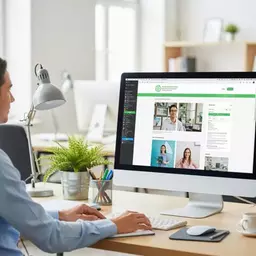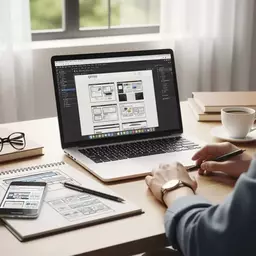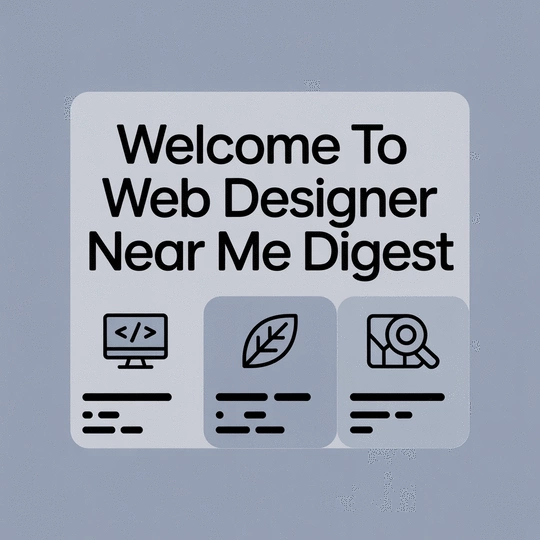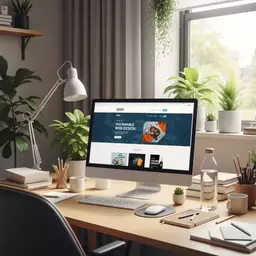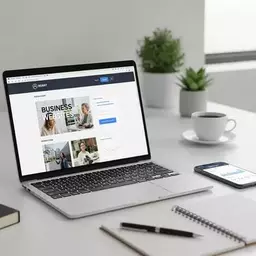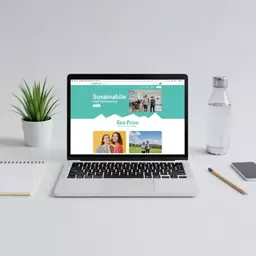Choosing a web designer can feel like an overwhelming task, especially with the multitude of options available. But what if you had a clear roadmap to guide your decision? By understanding your needs and evaluating designers effectively, you can find the perfect partner to bring your vision to life.
What You Will Learn
- Define your website's purpose to align your design needs effectively.
- Identify essential features that enhance user experience and support your business model.
- Evaluate designers based on portfolio quality and technical skills, focusing on creativity and functionality.
- Understand the importance of local SEO to enhance visibility among Australian users.
- Assess communication styles to ensure a collaborative and productive partnership with your designer.
- Gather feedback and reviews to gauge the reputation and reliability of potential web designers.
- Plan for post-launch support to maintain and update your website effectively.
Key Factors in Choosing a Web Designer
Understanding the critical elements involved in selecting a web designer is essential for a successful project. This visual breaks down the primary considerations into three core areas: defining your needs, evaluating designers, and understanding engagement models.
1. Defining Your Needs
- ✓ Website's Purpose
- ✓ Essential Features
- ✓ Aesthetic Style
2. Evaluating Designers
- ✓ Portfolio Quality
- ✓ Technical Skills
- ✓ Local SEO Knowledge
3. Final Selection Tips
- ✓ Communication Style
- ✓ Pricing & Contracts
- ✓ Post-Launch Support
Ready to Start?
Take action now and find the perfect web designer!
Get a QuoteNavigating Your Options for Web Design in Australia
Choosing a web designer is a big decision, and it’s essential to navigate your options wisely. Before you dive into the search, let’s take a moment to explore the key factors that will shape your decision. You'll want to start by defining your website's purpose, identifying necessary features, and considering your overall aesthetic. For a comprehensive guide on website design and development, you can refer to resources like the U.S. Small Business Administration's business guide.
Understanding these elements will not only help you communicate your needs clearly but also set the stage for a successful collaboration with a designer. So, grab a cup of coffee and let’s break this down!
Understanding Your Needs When Choosing a Web Designer
When it comes to web design, knowing what you want is half the battle. Here are a few areas to consider:
- Website's Purpose: Is it for e-commerce, a portfolio, or a blog?
- Essential Features: Do you need customer login, contact forms, or a gallery?
- Aesthetic Style: What colors and layouts resonate with your brand?
By clarifying these points, you’ll make it much easier for potential designers to understand how they can help bring your vision to life.
Defining Your Website's Purpose
Outlining the specific goals for your website is crucial. Are you aiming to generate leads, sell products, or share information? Each goal requires a different approach in terms of design and functionality. This clarity helps you and your designer stay aligned throughout the project.
For example, if your goal is to drive sales, your website will need strong e-commerce capabilities, while a portfolio site should focus on showcasing your work beautifully!
Identifying Essential Features and Design Elements
Once you know your website's purpose, it’s time to identify the essential features that will support that aim. Consider functionalities like:
- E-commerce capabilities for online shops
- Responsive design for optimal viewing on all devices
- SEO optimization to improve search visibility
These elements not only enhance user experience but also ensure your site functions effectively within your business model. Remember, the right features can really elevate your website's performance! For further reading on effective website design, consider insights from Usability.gov on website design best practices.
Evaluating Local Web Designers: Key Factors
Now that you have a clearer understanding of your needs, it’s time to assess potential web designers effectively. Here are some critical factors to consider:
- Portfolio Quality: Look for creativity and functionality in their past work.
- Technical Skills: Ensure they are well-versed in mobile-first design and SEO strategies.
- Local SEO Knowledge: Find out how they can enhance your website's visibility among Australian users.
By focusing on these aspects, you can find a designer who truly aligns with your vision and technical needs.
Reviewing Portfolios: What to Look For
Analyzing design portfolios helps to gauge a designer's creativity and relevance to your industry. Pay attention to:
- The diversity of their design styles
- Client testimonials and case studies
- How well their past projects meet functional requirements
This evaluation will give you a sense of how well a designer can translate their skills into results that work for you. To better understand how to choose a web designer, insights from the Nielsen Norman Group can be particularly helpful.
Assessing Technical Skills and SEO Knowledge
It's vital to ensure that your chosen designer possesses strong technical skills. This includes understanding mobile-first design and the latest core web vitals. Strong technical knowledge will not only support the essential features of your website but also enhance search engine optimization for better visibility.
Ask potential designers about their approach to SEO and how they plan to integrate it into your site. This will be an important factor in your website's long-term success!
Understanding Local SEO and Its Impact on Your Website
Local SEO strategies can significantly enhance your website's visibility among Australian users. By optimizing for local search terms and using geo-targeted keywords, you can attract customers in your area effectively. A designer familiar with these strategies will help ensure that your website reaches the right audience.
As you consider local SEO, think about your target market and how you can connect with them through your online presence—this is where a knowledgeable designer can make a big difference!
The Freelancer vs. Agency Debate in Australia
As you move forward, you might find yourself weighing the pros and cons of hiring freelancers versus design agencies. Each has its unique advantages that can fit different project needs.
Frequently Asked Questions (FAQs)
- What are the key factors to consider when choosing a web designer?
- The key factors include defining your website's purpose, identifying essential features, evaluating designers' portfolios and technical skills (including SEO knowledge), assessing their communication style, understanding pricing and contracts, and planning for post-launch support.
- Why is it important to define my website's purpose?
- Defining your website's purpose (e.g., e-commerce, portfolio, blog) is crucial because it dictates the design, functionality, and overall strategy needed. This clarity helps your designer create a site that effectively meets your specific goals.
- What should I look for when reviewing a web designer's portfolio?
- When reviewing a portfolio, look for the diversity of their design styles, client testimonials, case studies, and how well their past projects meet functional requirements. This helps assess their creativity and ability to deliver relevant results.
- How important is a web designer's knowledge of local SEO?
- A web designer's knowledge of local SEO is very important, especially for businesses targeting a specific geographic area. It ensures your website is optimized for local search terms and geo-targeted keywords, significantly enhancing visibility among your local audience.
- What kind of post-launch support should I expect from a web designer?
- Post-launch support typically includes website maintenance, updates, security monitoring, and technical assistance. It's important to discuss and agree upon a clear plan for ongoing support to ensure your website remains functional and up-to-date.
Engage with Us!
We want to hear your thoughts! When selecting a web designer, what factor is most important to you? Is it their portfolio quality, technical skills, or perhaps their understanding of local SEO? Share your opinion below:
Summarizing Your Path to the Right Web Designer
Choosing the right web designer can feel overwhelming, but it doesn’t have to be! By reflecting on the essential steps and considerations we’ve discussed, you’ll be well-prepared to make an informed decision. Here’s a quick recap of the journey we’ve taken together:
Final Tips for Effective Selection
As you head towards selecting a web designer, keep these critical points in mind:
- Understand Your Needs: Define your website's purpose and outline the essential features.
- Evaluate Portfolios: Look for creativity and relevance in designers' past work.
- Assess Technical Skills: Ensure they have the necessary knowledge of SEO and mobile-first design.
- Consider Communication: Find a designer whose style aligns with your expectations.
- Gather Feedback: Seek out reviews and testimonials to gauge designer reputation.
- Be Aware of Pricing: Understand expected costs and negotiate payment terms upfront.
- Plan for Post-Launch Support: Ensure there’s a clear plan for website maintenance.
This list serves as a handy reference as you embark on your search for the perfect designer. It’s all about ensuring the designer aligns with your vision and needs.
Encouraging Action: Take the Next Steps
Now that you have the tools and insights, it’s time to take action! I invite you to reach out to potential designers or agencies to discuss your specific needs and expectations. This conversation can provide clarity and help you gauge whether they’re the right fit for your project.
Don’t forget to share your experiences along the way! Have you worked with a designer before? What did you learn from that experience? If you have any follow-up questions or need further guidance, feel free to ask. Let’s keep the conversation going and empower each other in our web design journeys!
Recap of Key Points
Here is a quick recap of the important points discussed in the article:
- Understand Your Needs: Clearly define your website's purpose and outline essential features to guide your designer.
- Evaluate Portfolios: Look for creativity and relevance in designers' past work to ensure they fit your vision.
- Assess Technical Skills: Ensure your designer is knowledgeable in SEO and mobile-first design for optimal performance.
- Consider Communication: Choose a designer whose communication style aligns with your expectations for a smoother collaboration.
- Gather Feedback: Seek out reviews and testimonials to gauge the designer's reputation and reliability.
- Be Aware of Pricing: Understand expected costs and negotiate payment terms upfront to avoid surprises.
- Plan for Post-Launch Support: Ensure there is a clear plan for ongoing website maintenance after launch.


